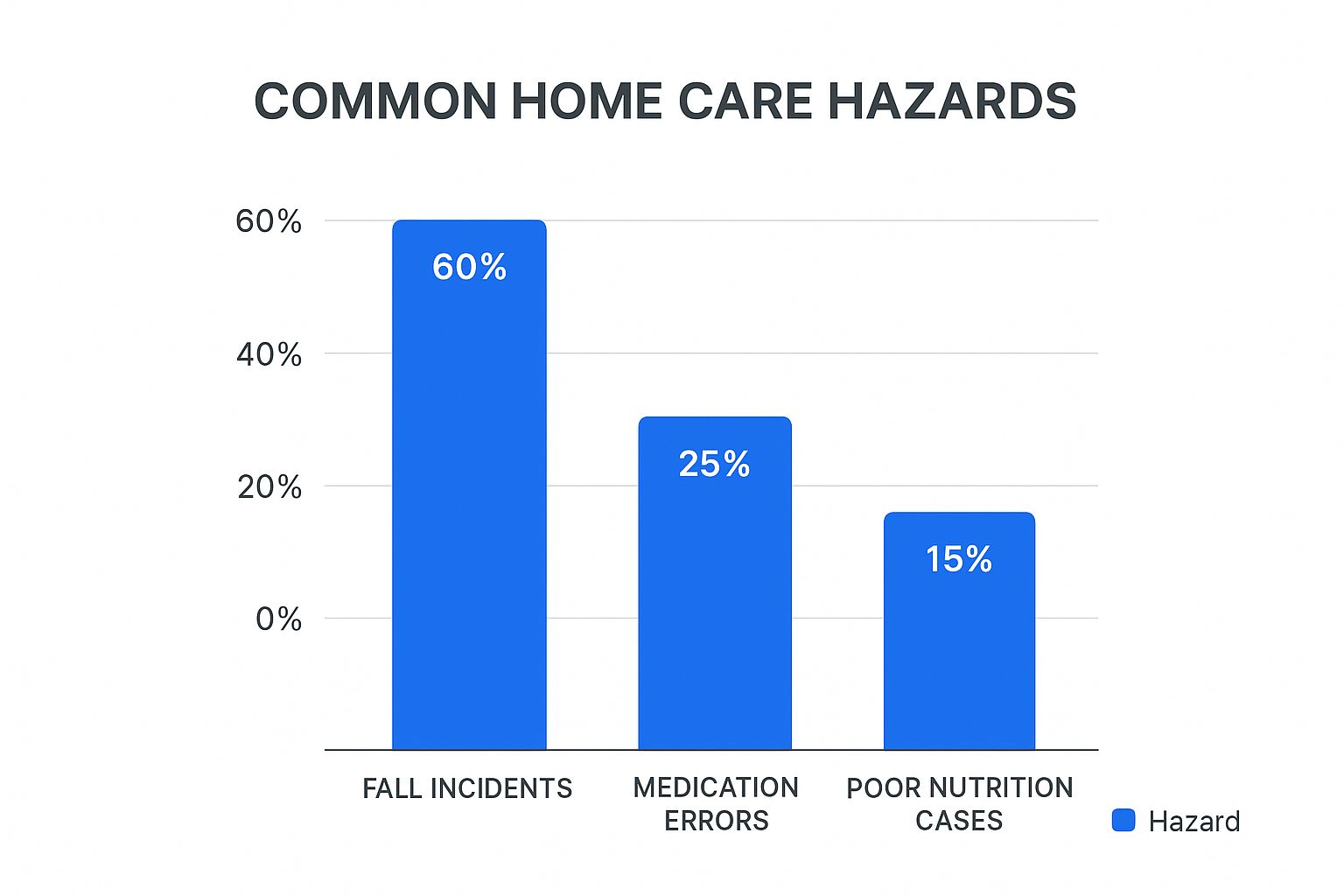The Truth About Home Care for Elderly: Myths vs. Reality

Many people believe that home care signals a loss of independence for elderly individuals. However, this is a misconception. In reality, home care can actually bolster independence. By providing assistance with daily tasks, it allows seniors to remain in the comfort of their own homes.
This familiar environment offers a sense of control and stability, unlike the sometimes disorienting experience of moving to a care facility. This, in turn, has a positive impact on their mental and emotional well-being.
Another common myth is that home care is a uniform service. This couldn't be further from the truth. Home care is highly personalized. Services can range from simple companionship and meal preparation to specialized medical care from skilled nurses, addressing a wide array of needs.
Choosing the right level of care is vital to ensure seniors receive appropriate support. This underscores the importance of understanding the diverse types of home care available. For more information on finding in-home care, check out this helpful guide: How to find in-home care for the elderly.
Understanding the Growing Need for Home Care
The rising demand for home care services is fueling significant growth in the elderly care market. The global elderly care services market was valued at $1044.86 billion in 2024.
Projections indicate it will reach $1132.54 billion by 2025, demonstrating a CAGR of 8.4%. This expansion highlights a growing preference for home-based care over institutional options. Families are increasingly recognizing the advantages of home care for their aging loved ones. For more detailed market statistics, see this report: Find more detailed statistics here.
Addressing Caregiver Burnout
While rewarding, providing home care can also be demanding. Caregiver burnout is a serious concern, especially for family members balancing caregiving with other responsibilities.
It's crucial to recognize the signs of burnout and take proactive steps to address them. This includes seeking support, setting realistic expectations, and prioritizing self-care. For helpful strategies, explore these proven strategies to prevent caregiver burnout.
Ultimately, the caregiver's well-being is paramount to ensuring sustainable and high-quality home care. A healthy caregiver can better provide the necessary care and support for their loved one.
The following table summarizes various home care services, outlining key features and indicating when each type might be most suitable.
To help clarify the various types of home care available, we've compiled the following table:
Types of Home Care Services for Elderly
| Service Type | Key Features | Best For | Professional Required |
|---|---|---|---|
| Companionship | Socialization, light housekeeping, errands | Seniors who need help with daily tasks and combatting loneliness | Not always, but can be beneficial |
| Personal Care | Bathing, dressing, grooming, mobility assistance | Seniors with physical limitations | Often a certified nursing assistant (CNA) or home health aide (HHA) |
| Skilled Nursing | Medical care, wound care, medication management | Seniors with complex medical needs | Registered Nurse (RN) or Licensed Practical Nurse (LPN) |
| Homemaker Services | Meal preparation, laundry, cleaning | Seniors who need help maintaining their home | Not always, but can be helpful |
| Respite Care | Temporary relief for family caregivers | Families needing a break from caregiving duties | Can be provided by various professionals or volunteers |
This table provides a brief overview of the diverse range of home care options. Selecting the right service depends on the individual needs and preferences of the senior and their family. Consulting with a healthcare professional or home care agency can help determine the most appropriate level of care.
Conducting a Care Assessment That Actually Works
A crucial step in arranging effective home care for elderly loved ones is conducting a thorough care assessment. This process goes beyond simple checklists, delving into the individual's specific needs and preferences. It's about understanding their current capabilities and anticipating what they might need in the future.
Evaluating Physical and Cognitive Abilities
A comprehensive assessment involves evaluating physical capabilities. This includes assessing things like mobility, strength, and balance. It also looks at their ability to perform everyday tasks, such as bathing and dressing.
Evaluating cognitive health is also key. This means assessing memory, decision-making skills, and overall cognitive function. For example, observing how easily a loved one manages medications or follows instructions can offer valuable insights.
Assessing Emotional Well-being and Social Engagement
Beyond physical and cognitive abilities, emotional well-being is another critical part of a thorough care assessment. This means considering factors like mood, social interaction, and overall emotional state.
It's also important to evaluate their level of social engagement. Look for any potential feelings of loneliness or isolation. These observations can help tailor the care plan to address both emotional and practical needs.
Identifying Early Warning Signs and Changing Needs
One of the primary goals of a care assessment is to identify potential changes in needs before they become crises. This proactive approach allows for timely adjustments to the care plan. This ensures ongoing support and prevents unnecessary stress.
This involves recognizing subtle shifts in behavior or abilities that might indicate a decline in health or function. For example, difficulty with tasks that were previously managed easily could be a sign that they need more assistance.
Home health care is a critical part of elderly care, and a significant number of patients are seniors. Approximately 86% of home health care patients are aged 65 or older. This demographic often requires ongoing medical and non-medical support due to chronic conditions and mobility challenges. Explore this topic further: Find more detailed statistics here.
Having Difficult Conversations with Dignity
Conducting a care assessment often involves having difficult conversations about limitations and changing needs. These discussions should be approached with sensitivity and respect, prioritizing the individual's dignity.
One approach is to focus on the goal of maintaining independence and improving quality of life. By framing the conversation in a positive light, it can be easier to discuss sensitive topics. It's also easier to gather honest information about their capabilities and limitations.
This open communication ensures the care plan truly addresses their specific requirements. It also promotes their overall well-being and enables them to remain safely and comfortably in their own home.
Creating a Home That Supports Aging (Not Fighting It)

Adapting a home for an aging loved one is a thoughtful process. It's about more than just adding safety features; it's about creating a space that promotes both comfort and independence. The goal is to support their changing needs while maintaining a sense of dignity and familiarity.
Bathroom Modifications for Fall Prevention
The bathroom can be a particularly hazardous area for seniors. Simple changes can greatly reduce the risk of falls. Installing grab bars near the toilet and in the shower provides essential support.
Replacing a standard bathtub with a walk-in shower is another effective modification. This removes a significant obstacle and allows seniors to bathe safely and independently, promoting both security and peace of mind.
Enhancing Cognitive Function Through Lighting
Adequate lighting is key for maintaining cognitive function in older adults. Brightening up the home can improve visibility and reduce disorientation, especially in high-risk areas like hallways and stairwells.
Natural light offers additional benefits. Opening curtains to let in sunlight or installing skylights can improve mood and sleep quality. This small change can make a significant difference in a senior's overall well-being.
Smart Home Technology: Hype vs. Help
Smart home technology offers a range of options for supporting aging in place. It's crucial, however, to choose technologies that offer real value. Motion-activated lighting, for instance, can automatically illuminate pathways at night, preventing falls.
A Personal Emergency Response System (PERS) is another helpful tool. It provides immediate access to assistance in the event of a fall or other emergency, enhancing safety and independence.
Room-by-Room Solutions for Changing Needs
Adapting a home for home care for elderly requires a room-by-room assessment. Consider the individual's needs in each space. In the kitchen, lowering countertops and adding pull-out shelves can simplify meal preparation.
In the bedroom, adjusting bed height and ensuring clear pathways can improve mobility. These modifications create a supportive environment while preserving a sense of comfort and familiarity. Making these changes can significantly improve a senior's quality of life at home. You can find more resources for senior meal preparation at Caring Hands Senior Services.
Building Your Professional Support Team: Beyond Basics

The infographic above highlights common home care hazards. Falls make up a significant 60% of incidents. Medication errors account for 25% of challenges, while poor nutrition represents 15%. Addressing these key areas is crucial for ensuring a safe and healthy environment for your loved one.
Arranging home care can be daunting. Building a strong professional support team is key to providing the best care. This means understanding the different professional roles and choosing the right fit for your loved one's needs.
Decoding the Roles and Responsibilities of Care Providers
A variety of care providers exist, each with unique skills. Companions offer non-medical support, focusing on socialization and daily tasks like errands or light housekeeping. This helps combat loneliness and maintain a sense of normalcy.
Certified Nursing Assistants (CNAs) and Home Health Aides (HHAs) provide personal care, like bathing and dressing. For medical needs, such as wound care or medication management, a Registered Nurse (RN) or Licensed Practical Nurse (LPN) is necessary.
Essential Interview Questions and Red Flags
Asking insightful questions during caregiver interviews is essential. Inquire about their experience with specific conditions, how they handle difficult situations, and their communication style.
Be cautious of vague answers or a reluctance to provide references. Always verify credentials and conduct background checks to ensure your loved one’s safety and well-being.
Coordinating Multiple Specialists: Avoiding Communication Breakdowns
Many families utilize multiple care providers. Clear communication is crucial for a coordinated approach. Establish clear expectations for each provider and encourage communication between them.
Regular check-ins and open dialogue can prevent misunderstandings and ensure everyone works towards the same goals. This collaborative approach fosters a supportive and effective care environment.
Managing Care Teams: Establishing Clear Expectations
Effective care team management involves clear boundaries and a defined structure. Designate a primary contact person to streamline communication and avoid confusion. This creates a central point for information and decision-making.
Address potential challenges promptly and respectfully. Proactive communication prevents small issues from escalating. The increasing need for elderly care is evident in market projections. The market is expected to reach $1931.98 billion by 2025, up from $1782.6 billion in 2024. For more statistics, Explore this topic further. By 2035, the market is projected to reach $2368.2 billion, a CAGR of 6.8% between 2025 and 2035. This underscores the growing demand for both home-based and institutional care.
To help understand the costs associated with various care options, see the table below:
Cost Comparison of Elderly Care Options
This table presents the average costs of different elderly care arrangements, helping families understand the financial implications of home care versus other alternatives.
| Care Type | Average Monthly Cost | Covered by Medicare? | Covered by Medicaid? | Out-of-Pocket Expenses |
|---|---|---|---|---|
| In-Home Care (Non-Medical) | $4,000 – $6,000 | Limited | Varies by state | Potentially high |
| In-Home Care (Skilled Nursing) | $5,000 – $8,000 | Limited, typically for short-term rehabilitation | Varies by state | Potentially high |
| Assisted Living | $4,500 – $7,000 | No | Varies by state, may cover some services | Potentially high |
| Nursing Home | $7,000 – $10,000+ | Limited, typically for short-term rehabilitation following hospitalization | Often covers long-term care if eligible | Can vary depending on coverage and facility |
Note: These costs are averages and can vary significantly based on location, level of care required, and specific services provided.
The table demonstrates the financial considerations involved in different care options. While in-home care can offer personalized attention, the out-of-pocket expenses can be substantial. Medicaid and Medicare coverage varies, highlighting the importance of careful planning and exploration of available resources.
Nutrition and Medication Systems That Actually Work

Providing effective home care for elderly individuals often focuses on nutrition and medication management. These essential aspects of daily life can become more challenging with age, requiring adaptable systems to meet individual needs. This goes beyond simple pill organizers and meal deliveries. It's about creating strategies that truly support overall well-being.
Addressing Nutritional Challenges in Seniors
Standard nutrition advice doesn't always work for seniors. Changes in taste and smell can make favorite foods less appealing. Decreased appetite and difficulty swallowing can also contribute to nutritional deficiencies.
Understanding the specific needs of senior nutrition is key. Simple changes, like adjusting food textures or using flavorful herbs and spices, can make meals more enjoyable. Find more tips in our article on How to master senior meal prep.
Practical Meal Preparation Strategies for Changing Abilities
Meal preparation can become difficult for seniors with limited mobility or dexterity. Adapting cooking methods and using assistive devices can help.
Pre-chopped vegetables can simplify cooking. Adaptive utensils, like weighted forks and knives, can make mealtimes easier and more enjoyable, promoting independence and better nutrition.
Technology's Role in Medication Adherence
Technology can be a valuable tool in medication management, but it's important to choose user-friendly solutions. Some apps and devices can be confusing. However, the right technology can offer real benefits.
Automated medication dispensers, for example, can provide reminders and dispense correct dosages, reducing the risk of errors. This technology is especially helpful for seniors managing multiple medications.
Coordinating Multiple Medications and Preventing Interactions
Many elderly individuals take multiple medications, increasing the risk of adverse drug interactions. Careful coordination is essential. A clear medication list, reviewed regularly with a doctor or pharmacist, is crucial.
This list should include all prescribed medications, over-the-counter drugs, and supplements. This helps prevent dangerous interactions and ensures medication safety.
Ensuring Proper Nutrition Despite Challenges
Maintaining proper nutrition for seniors with decreased appetite or dietary restrictions requires creative solutions. Offering smaller, more frequent meals can be more manageable than three large meals.
Nutrient-dense snacks and supplements can help fill nutritional gaps. This ensures seniors receive essential vitamins and minerals for optimal health, even with dietary limitations. This combined approach of practical strategies and technological solutions can significantly improve nutrition and medication management for seniors receiving home care.
Preventing Caregiver Burnout: Honest Strategies That Work
Caring for elderly loved ones at home is a rewarding yet demanding journey. It requires immense dedication and often puts caregivers at risk for burnout. Moving beyond simple self-care tips, let's explore practical strategies to create a sustainable caregiving experience. This involves honestly evaluating challenges, setting achievable expectations, and building a supportive network for genuine relief.
Recognizing the Signs of Burnout Before It's Too Late
Burnout goes beyond mere tiredness; it's a state of emotional, physical, and mental exhaustion. Persistent fatigue, irritability, sleep disturbances, appetite changes, and feelings of detachment or apathy are common signs. Early recognition is crucial.
For example, consistently withdrawing from social activities or feeling resentful about caregiving responsibilities are red flags. Caregiver burnout is a serious concern. Taking proactive steps, like those found on Whelm, to avoid it before reaching a breaking point is essential. This means acknowledging your limitations and seeking support.
Building a Meaningful Support Network
A robust support system is fundamental to preventing burnout. This goes beyond casual friendships. It's about cultivating connections with people who understand the unique challenges of caregiving.
Consider joining a support group or connecting with fellow caregivers online. Even reaching out to trusted friends and family can make a difference. Sharing experiences and getting advice from those who've faced similar situations offers valuable emotional support and practical guidance. Learn more about building a support network through resources like those available at Caring Hands Senior Services.
Respite Care: Finding Genuine Relief
Respite care offers temporary relief from caregiving duties, allowing you to recharge and focus on personal needs. This could involve a friend or family member stepping in for a few hours, hiring a professional caregiver, or using adult day care services.
Finding truly restorative respite options is vital. This could mean engaging in enjoyable activities or simply having uninterrupted time for rest and relaxation. The key is prioritizing activities that rejuvenate your energy and well-being.
Accessing Underutilized Financial Resources
Many caregivers are unaware of available financial resources. These include government programs, grants from non-profit organizations, and tax credits designed for caregivers. Exploring these options can ease the financial burden of home care and provide funds for additional support services.
These funds could be used to hire professional respite care, cover medical appointment transportation costs, or even finance home modifications for easier caregiving.
Managing Family Dynamics and Addressing Guilt
Navigating family dynamics can be a major stressor for caregivers. Disagreements about responsibilities, differing opinions on care approaches, and unresolved family conflicts can intensify an already demanding situation. Open and honest communication, establishing clear communication channels, and seeking professional mediation, if needed, can foster a more supportive family environment.
Many caregivers experience guilt, which can stem from feeling overwhelmed or worrying about not doing enough. Addressing these feelings constructively is important. Recognize that guilt is a normal emotion and seek support from therapists or counselors specializing in caregiver support. Remember, providing the best care involves caring for yourself too.
Maintaining your own identity while caregiving is crucial for preventing burnout. This means making time for enjoyable activities, pursuing hobbies, and connecting with friends and family outside of your caregiving role. While it's easy to become consumed by caregiving demands, remember that nurturing your own well-being isn't selfish; it's essential for sustainable caregiving.
Contact Caring Hands Senior Services today at https://caringhandsseniorservices.org to learn how we can help you and your loved one on this journey. We offer personalized care plans to meet individual needs and provide the respite and support you deserve.

